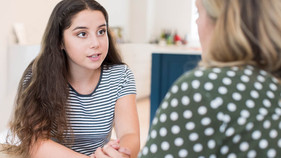From nonstop “breaking news” updates to school shutdowns, the daily impact of the novel coronavirus (COVID-19) pandemic is difficult for adults to handle. So, imagine the impact it has on children.
Thankfully, there are many ways to help ease children’s anxieties and educate them about COVID-19. “All of them begin with honesty,” said Dr. Jessica Mattingly, a child and adolescent psychologist with Penn State Health Medical Group. “By being open to children’s questions and answering them age appropriately, parents can create an environment where their children feel safe.”
Start the conversation with a simple question. “Ask a child, ‘What do you already know about COVID-19?’” Mattingly said. “Their answer may surprise you.”
Once parents learn what their children already know about COVID-19, they can help fill in the gaps by talking about how COVID-19 spreads and how it’s impacting the world. “It’s important for children to know that most people who get the virus don’t get very sick and may feel like they have a bad cold with a fever,” Mattingly said.
It’s OK to tell children COVID-19 can be fatal. “But also let them know there are lots of experts — doctors, scientists and nurses — who have trained their whole life to handle situations like this, and they’re working to help sick people get better and stay healthy,” Mattingly said.
Emphasizing steps children can take to limit COVID-19’s spread can provide a sense of control. Consider making hand hygiene part of a family’s routine before every meal and snack. “Make it fun,” Mattingly said. For example, for younger children, play a favorite song, such as “Twinkle, Twinkle Little Star” during handwashing time to make sure they do it for at least 20 seconds. Also, show children how to cover sneezes and coughs with their elbow. And encourage them to tell Mom and Dad if they feel sick.
For school-age children and adolescents, ask them to avoid social media as their main news source about COVID-19. If they quote posts they’ve read on social sites as “facts,” ask them to see if it matches the guidance from the Centers for Disease Control and Prevention and World Health Organization.
No matter a child’s age, tailor the conversation to help validate, reassure and relate to their concerns. “Let your children know their feelings are OK,” Mattingly said. For younger children, uncomfortable feelings are the mind’s way of telling them to take care of their bodies. For school-age and adolescent children, uncomfortable feelings mean they deeply care about the situation.
Parents should also lead by example by modeling good behavior, from handwashing to maintaining social connections to keeping a set schedule at home. “That will provide a sense of structure during these stressful times,” Mattingly said.
Some children may still exhibit anxiety no matter how well the discussion goes. Warning signs of anxiety disorders for preschoolers include fear of being alone, increased separation anxiety, increased tantrums, clinginess or regression in achieved milestones like speech and using the toilet. Warning signs for school-age children include irritability, aggressive behaviors, nightmares, stomachaches or headaches, and appetite or sleep disturbances. Adolescents may display those same symptoms along with an increase or decrease in energy, isolation or avoidance of healthy behaviors.
Many resources exist to help parents guide children with high levels of anxiety. The National Child Traumatic Stress Network prepared this handout to help families cope with COVID-19. UNICEF developed these guidelines for talking with children about coronavirus. And the Substance Abuse and Mental Health Services Administration maintains a free 24/7 national helpline, available at 800-985-5990 or by texting “talk with us” to 66746.
Related content:
The Medical Minute is a weekly health news feature produced by Penn State Health. Articles feature the expertise of faculty, physicians and staff, and are designed to offer timely, relevant health information of interest to a broad audience.



